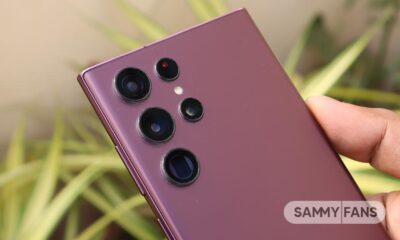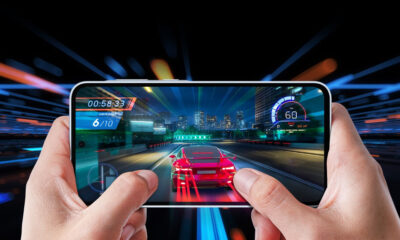Phones
Samsung Galaxy Z Fold 4 to be the lightest foldable phone this year

Samsung’s two new foldable smartphones – Galaxy Z Fold 4 and Galaxy Z Flip 4 are coming to the markets shortly. This year, the company will be introducing major changes in smartphones compared to the previous models. Earlier this week, a leak exposed the full specifications of the upcoming Samsung Galaxy Z Fold 4.
Meanwhile, a new information has started surfing online which reveals the weight of the device. According to the tipster Ice Universe, the Samsung Galaxy Z Fold 4 will be the lightest foldable smartphone this year. It will weigh only 254 grams.
Join SammyFans on Telegram
The Galaxy Z Fold4 will be the lightest Fold phone this year at only 254 g. (258g and 260g are not accurate)
— Ice universe (@UniverseIce) June 2, 2022
You might think that with such low weight, Samsung will compromise on the battery of the device and will put a small-sized battery. But this is not true. Samsung Galaxy Z Fold 4 will sport a 4400mAh battery that will support 25W charging, which is enough to use the phone throughout the day.
DOWNLOAD SAMMY FANS APP

Samsung Galaxy Z Fold 4 major design changes:
Yes, you have heard right, the Galaxy Z Fold 4 will introduce major design changes when compared to its predecessor. As per the reports, the device will look shorter in length. However, it is slightly wider and the screen view size has been improved as well.
Samsung Galaxy Z Fold 4 has a smaller hinge, which makes the screen view size wider, providing users a better picture experience when unfolded. Beyond this, if you are expecting an S Pen slot with the phone, you might be disappointed to know that the company has not added a slot for S Pen.
To know more about the device, please visit our dedicated tracker which is linked below –
Get notified –
Aside from SammyFans’ official Twitter and Facebook page, you can also join our Telegram channel, follow us on Instagram and subscribe to our YouTube channel to get notified of every latest development in Samsung and the One UI ecosystem. Also, you can follow us on Google News for regular updates.
Phones
Samsung Galaxy Z Flip 6 US model packs Snapdragon 8 Gen 3 processor

The US variant of Samsung Galaxy Z Flip 6 will be equipped with a Snapdragon 8 Gen 3 processor. There were reports that Samsung may expand the Exynos chipset to its foldable lineup, which doesn’t seem to be happening, at least in the United States.
Recently, Samsung Galaxy Z Flip 6 US variant was spotted on Geekbench with Snapdragon chip. It isn’t surprising as the company is following its conventional chipset strategy. We expect that it will be the same chipset used in the Galaxy S24 Ultra, the Snapdragon 8 Gen 3 for Galaxy.
The Flip 6 smartphone scored 15084 points on Geekbench’s GPU test. Due to its foldable form factor, the device may miss a Galaxy S24-like larger cooling technology. Still, its impressive 15000+ points in the GPU test indicates that Samsung has greatly optimized the software.
The company still has three months remaining in the launch event. More performance improvements will likely be achieved before the Unpacked. The South Korean tech giant will likely unveil the next-gen foldable phones in mid-July.
This year, the Galaxy Z Fold 6 Ultra would join the standard Galaxy Z Fold 6 and the Galaxy Z Flip 6. In addition, an affordable variant of Fan Edition branding is also in development. However, the cheaper foldable would miss some pro-grade specs to maintain the price.
Stay up-to-date on Samsung Galaxy, One UI & Tech Stuffs by following Sammy Fans on X/Twitter. You can also discover the latest news, polls, reviews, and new features for Samsung & Google Apps, Galaxy Phones, and the One UI/Android operating system.
Do you like this post? Kindly, let us know on X/Twitter: we love hearing your feedback! If you prefer using other social platforms besides X, follow/join us on Google News, Facebook, and Telegram.
Phones
Galaxy M35 5G surfaces on Samsung India site after FCC and Dekra’s OK

Samsung seems all set to introduce Galaxy M35 5G in India. The phone has surfaced on Samsung India support website and the FCC and Dekra certification database. The development indicates that the official launch is not far away, at least in India.
The unreleased Galaxy M35 5G made its first appearance on the Samsung India support website. The listing revealed nothing other than the phone’s model number – SM-M356B. As spotted by 91mobiles, the upcoming handset has also received certification from FCC and Dekra.
Listing on the FCC database revealed that the Galaxy M35 5G features NFC, LTE, and 5G. It’s also confirmed that the device supports 25W fast charging, lagging behind its elder brother – Galaxy M55 5G, which supports fast charging up to 45W.
Dekra certification disclosed that the phone packs a 5880mAh battery, which Samsung will market as 6000mAh. Other features could include Android 14 OS out-of-the-box, Exynos 1380 chipset paired with 6GB of RAM as well as a modern punch hole display.
Stay up-to-date on Samsung Galaxy, One UI & Tech Stuffs by following Sammy Fans on X/Twitter. You can also discover the latest news, polls, reviews, and new features for Samsung & Google Apps, Galaxy Phones, and the One UI/Android operating system.
Do you like this post? Kindly, let us know on X/Twitter: we love hearing your feedback! If you prefer using other social platforms besides X, follow/join us on Google News, Facebook, and Telegram.
Phones
Samsung’s new 5G modem fuels satellite connectivity in Google Pixel 9 series
Google‘s Pixel 9 series is ready to introduce a significant upgrade with emergency satellite connectivity and new Samsung modem. This series aims to solve the persistent connectivity problems seen in previous Pixel models.
According to the information via AndroidAuthority, Samsung Modem 5400 will be integrated with Tensor G4 chips for the Pixel 9 series to bring significant improvements in terms of speed, power efficiency, and stability
The Pixel 9’s modem will support 5G non-terrestrial networks (NTN), which means it will enable satellite-based communication. This is particularly important for emergencies where standard network coverage is unavailable.
Moreover, this innovative feature is not exclusive to the Pixel 9. The next-generation Pixel Fold and a 5G tablet, currently under development, will also be equipped with the same modem.
One of the most notable features of this upgrade is the ability to connect with emergency services via satellite, which is crucial for users in areas without cellular coverage. To facilitate this, Google has implemented a system that guides users through a set of questions, allowing for quick communication with emergency responders. For example,
- What happened?
- [Are you/Are they/Is everyone] breathing?
- In total, how many people are [missing/trapped]?
- What best describes your situation?
- What is on fire?
- Are there weapons involved?
Although the release details for the 5G tablet are still unclear, the Pixel 9 series is expected to lead the way in mobile communication technology, ensuring users can remain connected in any location.
Google Pixel 9 renders reveal design overhaul, telephoto camera
Stay up-to-date on Samsung Galaxy, One UI & Tech Stuffs by following Sammy Fans on X/Twitter. You can also discover the latest news, polls, reviews, and new features for Samsung & Google Apps, Galaxy Phones, and the One UI/Android operating system.
Do you like this post? Kindly, let us know on X/Twitter: we love hearing your feedback! If you prefer using other social platforms besides X, follow/join us on Google News, Facebook, and Telegram.












